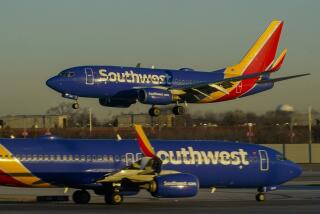Finding the Best Plane Seats by Knowing the Aircraft
- Share via
With more and more planes flying with full passenger loads than ever before, getting the best seats on a domestic flight is harder than ever.
Unfortunately, knowing what the best seats are isn’t easy because airlines fly many different aircraft, ranging from tiny commuter planes to jumbo 747-400s, and each airline buys different kinds of seats and configures those seats in their own way.
A starting point, however, is to know that on most airlines the narrow-body Boeing 737 and 757 planes--which have rows of three seats on each side of a middle aisle (a 3-3 configuration)--are real cattle cars in coach. Seats on these planes are narrow and legroom is tight, typically a knee-crunching 30 to 31 inches.
Many airlines now use these narrow-body planes for their longer flights, such as Los Angeles to Chicago, or on their less busy transcontinental flights such as Los Angeles to Newark or Philadelphia.
Better seats are found on the relatively new plane made by Europe’s Airbus consortium, the A320, which probably offers the most comfortable seats of the narrow-bodies. The cabin is 8 inches wider than the Boeing 737 and that extra space means 1-inch-wider coach seats.
Typically, more comfortable still are the wide-body aircraft: Boeing’s 777, 747 and 767 fall into this category, as do the DC-10 and McDonnell Douglas’ MD-11. Many wide-bodies offer more comfort in coach because the seats have an inch or two more legroom than seats in narrow-body planes.
“The Boeing 777 is the most comfortable wide-body plane for coach passengers,” said Ed Perkins, editor of Consumer Reports Travel Newsletter “The aisles are wider than the typical plane’s. The cabin ceiling is higher than a 747’s. Most important, most of the coach seats offer more space than other planes. They’re typically 20 1/2 inches wide between armrest mid-points, with 33 inches of legroom.”
Only a few airlines are flying the new Boeing 777; but United Airlines was among the first to take delivery, and it does fly them.
Although U.S. carriers usually fly wide-bodies to their international destinations, they also often are used on busy transcontinental routes. So, if you fly from LAX to New York City’s JFK, or to Washington’s Dulles Airport, you can enjoy wide-body comfort on certain flights.
When reserving seats on a wide-body, remember that the DC-10 and MD-11 typically have a 2-5-2 seat configuration, which maximizes the number of undesirable middle seats. The smaller, narrower 767, on the other hand, has 2-3-2 seating, which minimizes the number of middle seats.
Wide-body jets offer the most comfortable first class seats on domestic flights. The seats are comfortably upholstered, and they offer at least several inches more legroom than first class seats on a narrow-body plane.
No matter what type of plane, try to get the bulkhead seats, which offer extra legroom, because they are located just behind the partition (or bulkhead) that divides two different cabins (such as first class and coach). You not only have more legroom, there’s no passenger in front of you to recline his seat into your knees.
Most U.S. airlines now hold these desirable seats for full-fare passengers and the most active “elite-level” members of their frequent-flier programs. On American Airlines, for example, you must fly 25,000 miles a year to achieve the lowest level of elite status known as Aadvantage Gold. On United Airlines, you must fly 25,000 miles to earn their Mileage Plus Premier status.
But ask at the gate if one of the bulkhead seats is available. You’d be surprised how often a polite request will get you a still-empty bulkhead seat at the last minute.
Another option is to try to get seats in the emergency exit rows, which offer more legroom because they might be used to evacuate the plane in an emergency. Once again, most airlines hold these seats for full-fare passengers and their most loyal customers. But you can always ask at the gate.
“If you want good seats, you’ve got to be pro-active,” said Eric Weber, a vice president at City National Bank in Beverly Hills, who travels frequently. “When you reserve a flight with your travel agent or directly with an airline,” he said, “don’t automatically accept the seat they give you. Ask how the seating is laid out . . . you might get an emergency exit row seat with more legroom. And you’ll avoid a noisy seat next to the galley or lavatory.”
Still another strategy is to book your domestic flights on a wide-body plane that later goes onto international service, such as American Airlines’ flight No. 38, a wide-body 767 that flies from LAX to Chicago, and then on to a European destination. The 767 has more comfortable coach seats than the narrow-body MD-80s that handle most of American’s Los Angeles-to-Chicago flights. Avoid seats in non-reclining rows, located immediately in front of the emergency exit on some planes. A reclining seat could hinder an emergency evacuation; but it also means you’ll be frozen into the same position for the entire flight. The airline or your travel agent can identify these undesirable seats on their computerized seat map.
And avoid the noisy last rows, particularly in planes like the DC-10 and MD-80, which have rear-mounted jet engines. If the lavatories are located at the rear of the plane, passengers sitting in aisle seats in the rear-most rows also may be jostled by passengers waiting for the toilets.
More to Read
Inside the business of entertainment
The Wide Shot brings you news, analysis and insights on everything from streaming wars to production — and what it all means for the future.
You may occasionally receive promotional content from the Los Angeles Times.










